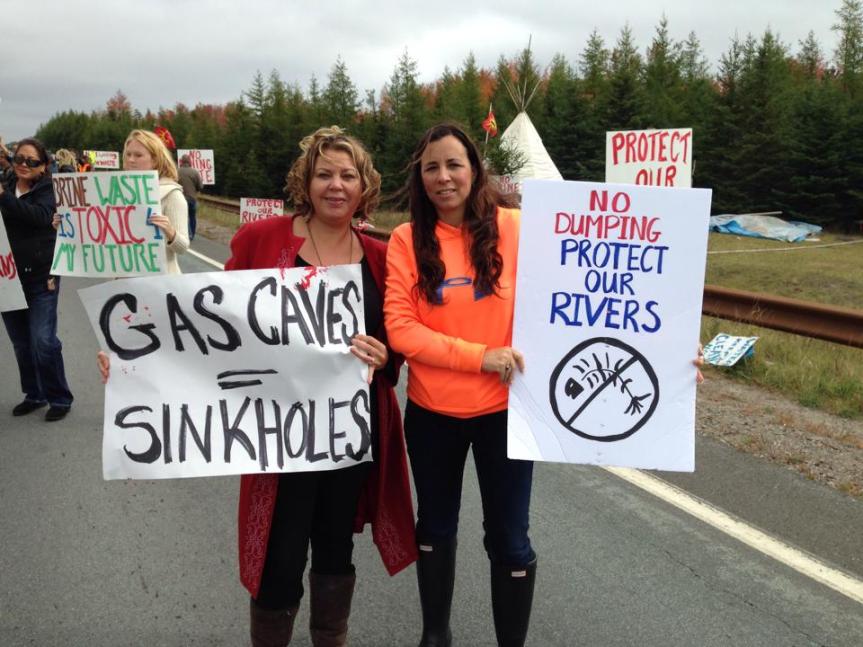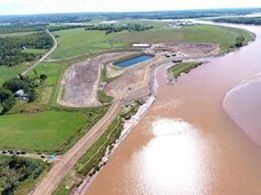
Alton Natural Gas Storage Limited is developing a huge storage site for hydrocarbons (natural gas and others) in Brentwood, Colchester County, Nova Scotia. They will use water from the Shubenacadie River to flush out underground salt deposits. “During construction of the caverns, brine will be released into a constructed channel connected to the Shubenacadie River where it will mix with the tidal (brackish) river water to maximize dilution.”¹ It will be directly discharged into the Shubenacadie River through the channel. The amount of salt from these caverns amounts to over 8 million cubic yards – 500,000 dump truck loads, depending upon how many caverns are created.

Photo taken with a drone, showing the channel created by Alton Gas. As you can see from the picture the channel is connected directly to the Shubenacadie River. Treaty Island, created by the construction of the channel is also visible.
This is of great concern to Mi’kmaq citizens, fishers, local landowners, environmental organizations and allies since this unique river ecosystem is home to several endangered and at risk species. The discharge site is near the mouth of the Stewiacke River, one of the last breeding grounds for striped Bass and also habitat for endangered Atlantic Salmon.
Despite continued outcry and court challenges from First Nations, local landowners and fishers regarding the lack of consultation and meaningful environmental assessments, the company has received all necessary approval. An overruling by the Minister of Environment, Premier or Federal Critical Habitat designation could still stop the project before the brine dumping takes place.


Looks good
LikeLike
Thanks
LikeLike
There has been a lot of smoke and mirrors in the Alta descriptions of the brining process. Using their published science and monitoring plan: This is how the process is allowed to proceed: Contrary to many descriptions of their process which show a pre-mixing pond/lagoon there is nothing identified in their brine discharge process that dilutes the 260 ppt prior to entering the river. The brine is lethal at 20 ppt to marine life. Their literature claims that our Environment Dept. and DFO have approved their Monitoring plan. This plan will not prevent fatal brine levels over 28 ppt entering the river, until indicated at both ends of the channel. At that time ( actually10 minutes later) it will take them 50 minutes to shut down the lethal brine which is spewing into the tidal boar upstream through the Shubie and into the Stewiacke River. The 4 inch brine discharge pipes have probably been designed to shut down in seconds. Alta also states in its literature that if eggs are observed in the channel the brining discharge can be shut down “immediately” Does anybody see any deceit here? Their process is designed to discharge a lethal brine as quickly as possible, not to protect the marine ecosystem. This process is the product of our Environmental Regulator. Alta has also repeated time and time again that they will mirror the back ground salinity levels. The process allows the level to be 7 ppt above the background. This means that, for example, a background of 20 ppt can be exceeded to 27 ppt. This is 33% above the normal background, well into the lethal range. This shock can accelerate mortality. Willie
LikeLike
Thanks Willie for providing more info on this. Willie Courtney is with the Shubenacadie River Commercial Fishers Association. He has a wealth of knowledge about the Shubenacadie River ecosystem.
LikeLike
What alton gas is doing is wrong on so many levels.
LikeLike
Why on earth do we have to fight our governments to see common sence, to see the future. The brine is not the only material that will be poured into the river ,NORMS ,mercury ,etc. Why does government allow these companies to put life and the future at risk for their monetary gain . It has to be a form of brain damage.
LikeLike